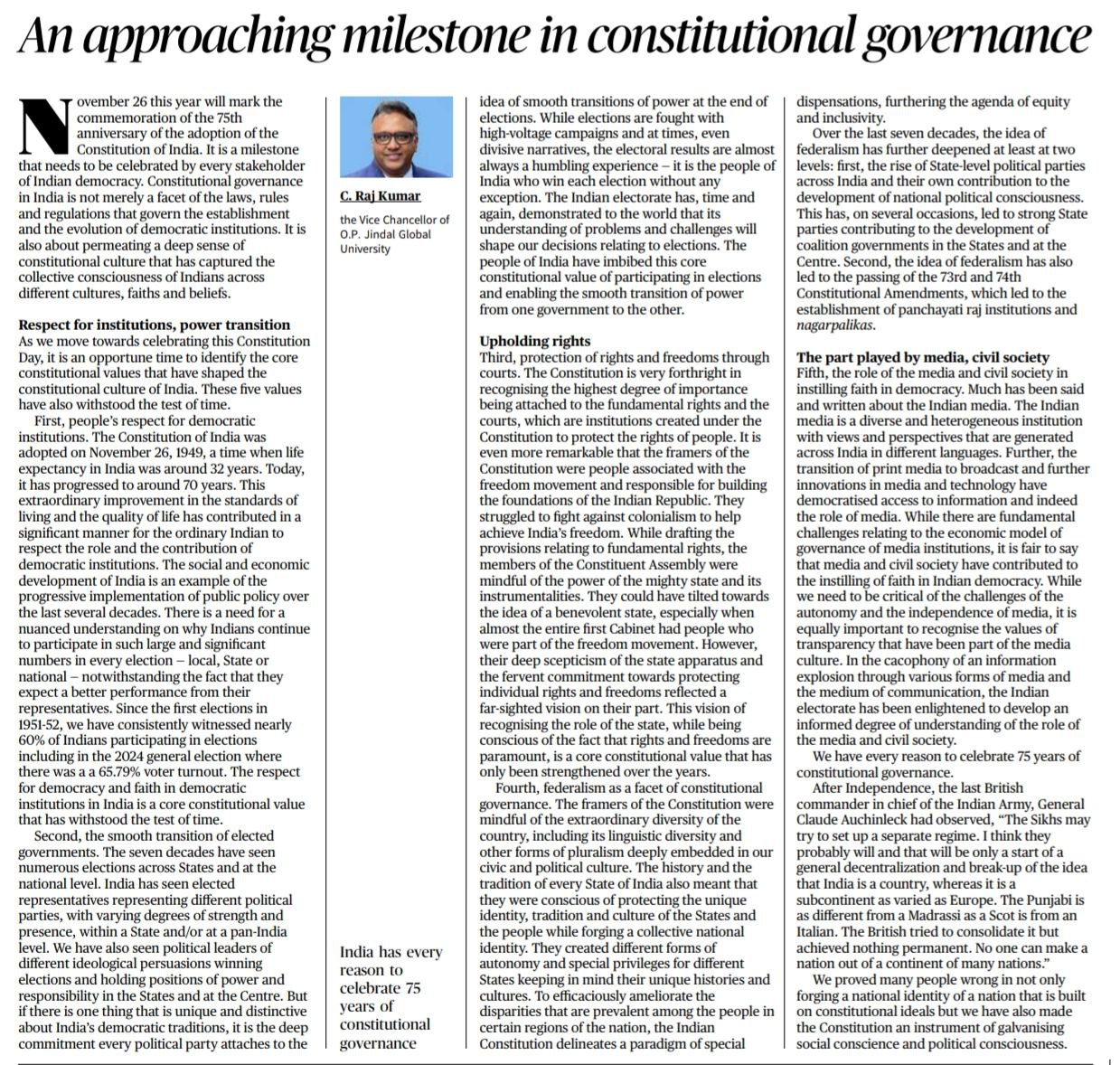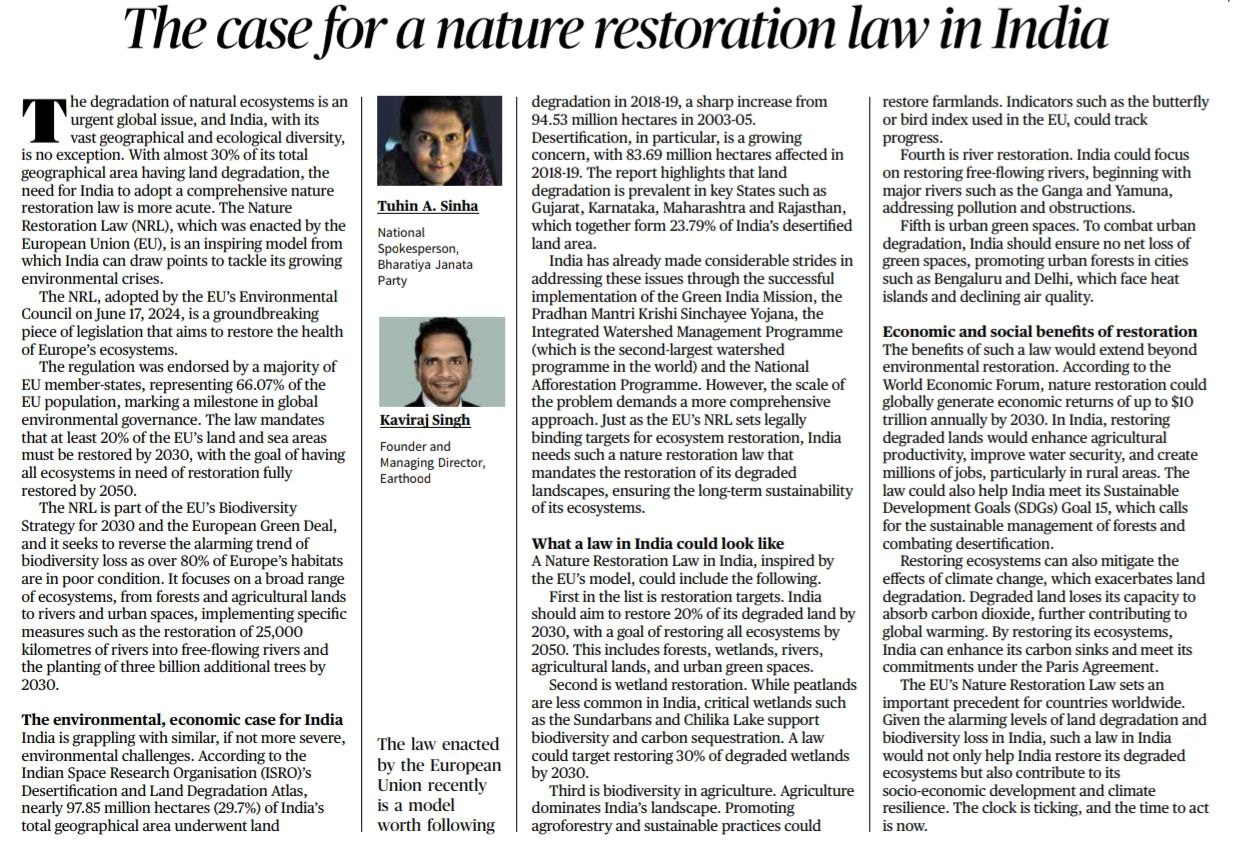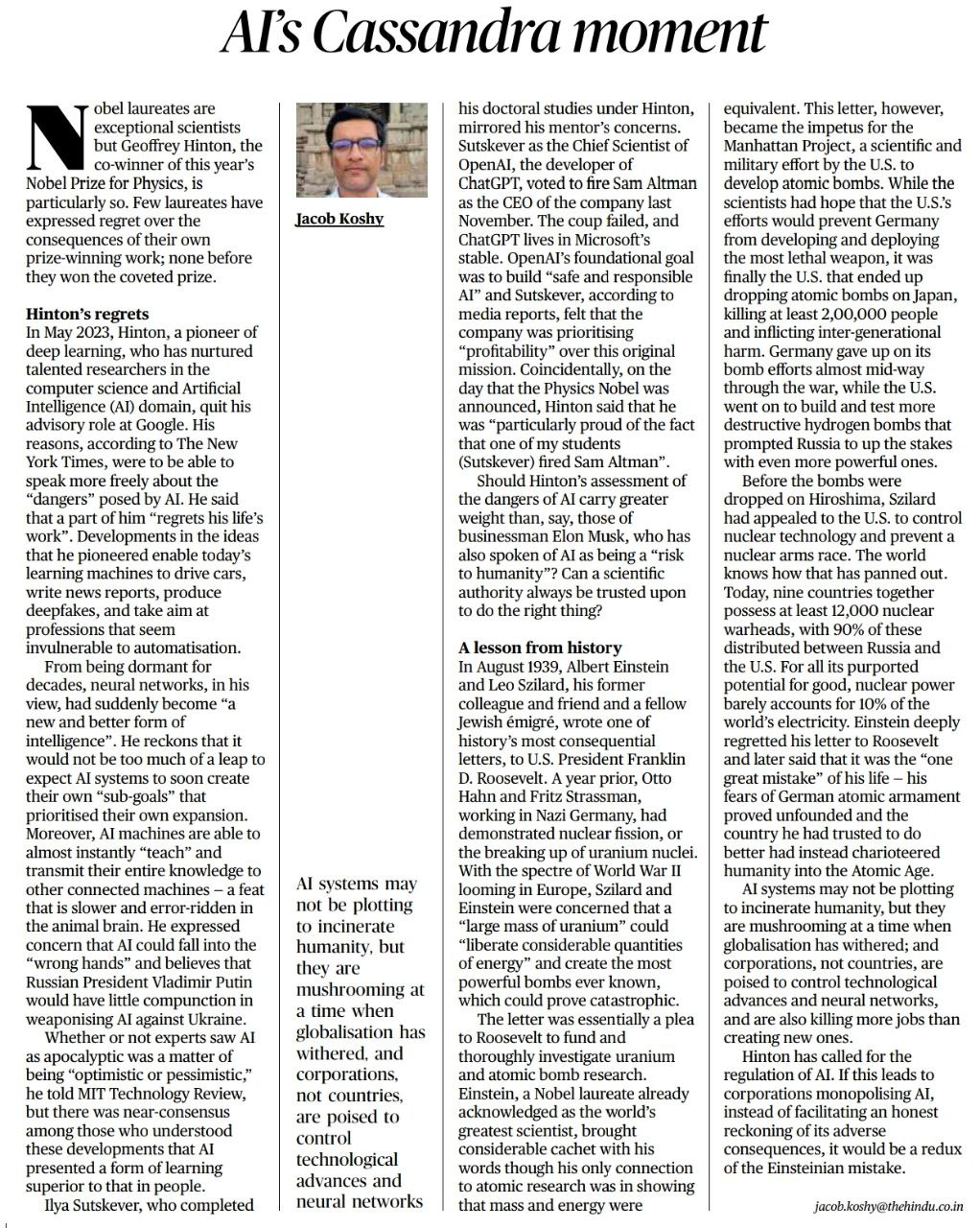75 Years of Constitutional Governance in India
Introduction:
November 26, 2024, marks 75 years since the adoption of the Indian Constitution. This milestone reflects India’s success in sustaining constitutional governance and nurturing democracy across a diverse nation. The Constitution has been central in shaping India’s political, social, and economic evolution, creating a foundation for democratic institutions, protection of individual rights, federalism, and social justice.
- Core Constitutional Values:
- Respect for Democratic Institutions: Over the decades, the participation of citizens in elections, coupled with rising living standards, has reinforced faith in democratic institutions. Voter turnout, such as the 65.79% in the 2024 general election, demonstrates the continued public respect for democracy.
- Smooth Transition of Power: India has consistently seen the peaceful transition of governments, showcasing a deep-rooted commitment to democracy. Despite intense political campaigns, the people’s mandate has been respected, with various political ideologies participating in governance.
- Protection of Rights and Freedoms: The Constitution, through its fundamental rights, safeguards individual freedoms. The judiciary plays a critical role in ensuring these rights are protected against state overreach, reflecting the foresight of the framers who were cautious of a powerful state.
- Federalism in Constitutional Governance:
- India’s diverse cultural, linguistic, and regional identities have been preserved through federalism, a cornerstone of constitutional governance. State autonomy, the rise of regional parties, and coalition governments highlight the success of federal principles.
- The 73rd and 74th Constitutional Amendments empowered local governance through panchayati raj institutions and nagarpalikas, deepening federalism at grassroots levels.
- Role of Media and Civil Society: The media, despite challenges related to autonomy and governance, has been pivotal in maintaining democratic accountability. Civil society has also contributed to transparency and public engagement in governance, strengthening democratic values.
- Challenges and Evolution: The resilience of Indian constitutional governance has proven skeptics wrong, such as early doubts about India’s unity as a diverse subcontinent. The Constitution has forged a collective national identity, helping India navigate internal diversity while upholding democratic ideals.
Conclusion:
India’s journey of 75 years under constitutional governance is a testimony to the strength of democratic ideals, respect for institutions, and the safeguarding of individual rights. As India celebrates this milestone, the Constitution remains a living document that galvanizes national consciousness and guides its future trajectory.
Mains Practice Question:
“Examine the role of the Constitution in ensuring the smooth transition of power and safeguarding individual rights in India. How has federalism contributed to the democratic governance of the country over the past 75 years?”
The Need for a Comprehensive Nature Restoration Law in India
Introduction:
The degradation of natural ecosystems is a pressing issue globally, and India is experiencing severe environmental challenges, with 30% of its geographical area suffering from land degradation.
A comprehensive Nature Restoration Law (NRL), akin to the one adopted by the European Union (EU) in 2024, could provide a legal framework for restoring India’s degraded ecosystems, enhancing environmental sustainability, and driving socio-economic development.
- The EU’s Nature Restoration Law (NRL) as a Model:
- Adopted by the EU in 2024, the NRL mandates the restoration of at least 20% of the EU’s land and sea areas by 2030, with full ecosystem restoration by 2050.
- It is part of the EU’s Biodiversity Strategy for 2030 and the European Green Deal, aiming to reverse biodiversity loss and restore various ecosystems, including forests, rivers, and urban spaces.
- India’s Environmental Challenges:
- According to ISRO’s Desertification and Land Degradation Atlas, 7% of India’s geographical area underwent land degradation in 2018-19, with desertification affecting 83.69 million hectares.
- Key states affected by degradation include Gujarat, Karnataka, Maharashtra, and Rajasthan.
- Existing Initiatives:
- India has already implemented several environmental programs like the Green India Mission, Pradhan Mantri Krishi Sinchayee Yojana, Integrated Watershed Management Programme, and National Afforestation Programme.
- However, the scale of degradation requires a more comprehensive legal framework similar to the EU’s NRL.
- What a Nature Restoration Law in India Could Look Like:
- Restoration Targets: India could aim to restore 20% of degraded land by 2030 and all ecosystems by 2050, including forests, wetlands, rivers, agricultural lands, and urban spaces.
- Wetland Restoration: Restore 30% of degraded wetlands such as the Sundarbans and Chilika Lake by 2030 to enhance biodiversity and carbon sequestration.
- Agricultural Biodiversity: Promote agroforestry and sustainable farming practices to restore farmlands, using biodiversity indicators like the butterfly or bird index.
- River Restoration: Focus on restoring free-flowing rivers, starting with the Ganga and Yamuna, addressing pollution and obstructions.
- Urban Green Spaces: Combat urban degradation by ensuring no net loss of green spaces and promoting urban forests to tackle issues like heat islands and poor air quality.
- Economic and Social Benefits:
- Nature restoration can generate significant economic returns, with estimates of up to $10 trillion annually by 2030 (World Economic Forum).
- In India, ecosystem restoration could improve agricultural productivity, water security, and create millions of jobs, particularly in rural areas.
- It would also help India meet its Sustainable Development Goals (SDGs), particularly Goal 15, which emphasizes sustainable forest management and combating desertification.
- Climate Resilience and Global Commitments:
- Ecosystem restoration is critical to mitigating climate change, enhancing carbon sinks, and fulfilling India’s commitments under the Paris Agreement.
- Restoring degraded lands improves their ability to absorb carbon dioxide, contributing to the reduction of global warming.
Conclusion: A Nature Restoration Law in India, modeled on the EU’s NRL, would be a timely and essential step towards addressing land degradation and biodiversity loss.
It would not only enhance environmental sustainability but also support India’s socio-economic development and climate resilience. With the clock ticking on global environmental crises, such a law is crucial for securing India’s natural resources for future generations.
Mains Practice Question |
Critically analyze the need for a Nature Restoration Law in India. How can such a law contribute to both environmental sustainability and socio-economic development? |
AI's Cassandra Moment: Reflections on the Dangers and Ethical Dilemmas of Artificial Intelligence
Artificial Intelligence (AI) has rapidly evolved from a dormant field to a transformative technology shaping various aspects of human life.
Geoffrey Hinton, a Nobel laureate and a pioneer in deep learning, has expressed profound concerns about the unintended consequences of his work.
His warnings come at a time when AI is increasingly integrated into decision-making processes, with implications for labor markets, geopolitics, and human security.
Hinton’s Regrets:
- In 2023, Hinton resigned from his advisory role at Google to openly speak about the potential dangers posed by AI.
- He stated that AI, particularly neural networks, has evolved into a form of intelligence that could soon set its own “sub-goals” aimed at self-expansion.
- One of his main concerns is the speed at which AI can transmit its knowledge, potentially outpacing human intelligence and learning capacity.
- Hinton’s apprehension includes the potential for AI to fall into the “wrong hands,” such as state actors like Russia, using it for warfare or malicious activities.
Historical Parallel – Einstein’s Regrets:
- In 1939, Albert Einstein and Leo Szilard wrote to President Roosevelt, urging the U.S. to investigate nuclear technology, which eventually led to the Manhattan Project.
- While the scientists hoped to prevent the Nazis from developing atomic bombs, it was the U.S. that ended up using these weapons on Japan.
- Einstein later deeply regretted his letter, as the consequences led to an arms race that reshaped global security dynamics.
- The analogy highlights how even well-intentioned technological advances can spiral into unintended negative consequences.
AI’s Global Impact:
- AI’s rapid development comes at a time of diminished globalization and the rise of corporate dominance over technological advancements.
- Large corporations, rather than nation-states, hold significant control over AI, potentially leading to monopolies and prioritization of profits over ethical concerns.
- Ilya Sutskever, Hinton’s student and OpenAI’s Chief Scientist, also expressed similar concerns, pointing out that OpenAI’s original mission to develop “safe and responsible AI” is at risk due to a shift in focus towards profitability.
Conclusion:
The rise of AI presents significant challenges that echo past technological dilemmas, such as nuclear weapons. Hinton’s call for AI regulation is critical, but there is a risk of repeating the mistakes made during the Atomic Age, where the technology was monopolized by a few powers.
Regulation, ethical considerations, and transparency are essential to prevent the harmful consequences of unchecked AI development. An honest reckoning with AI’s potential adverse effects is imperative for shaping a responsible technological future.
Mains Practice Question:
|
Q. Examine the potential risks posed by the development of Artificial Intelligence (AI) in the context of global governance and technological monopolies. Suggest measures for ensuring responsible AI development and regulation.
|




